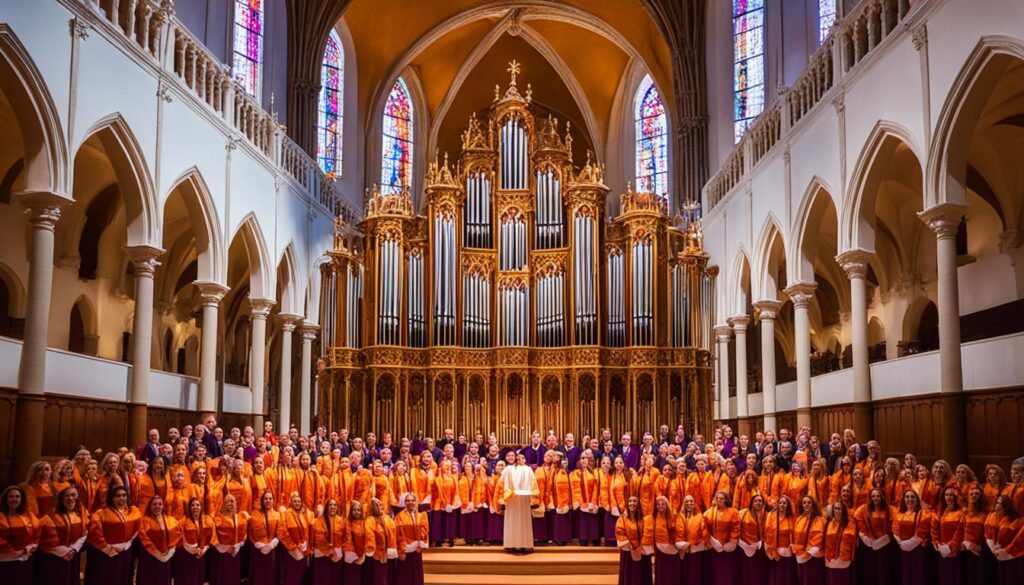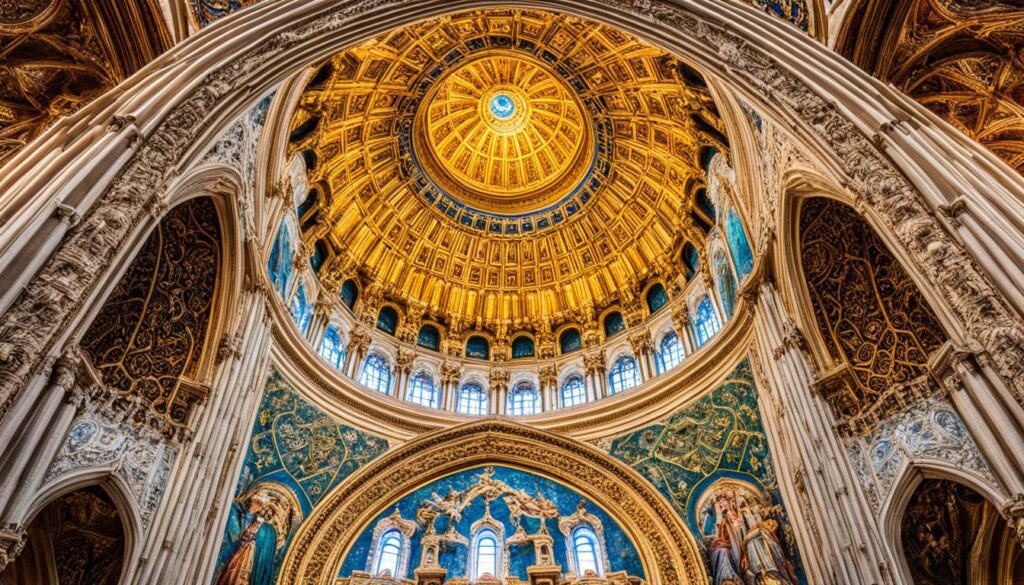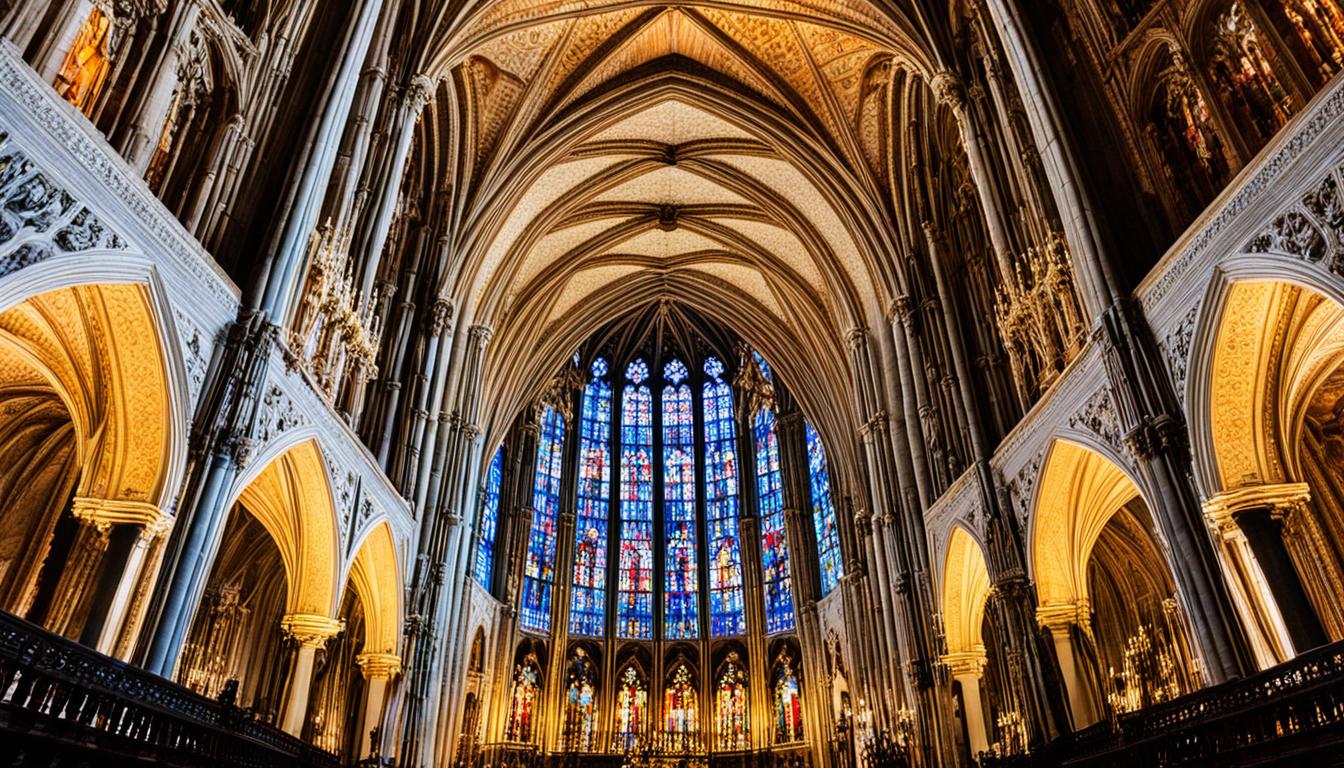The Cathedral of Granada, also known as the “Cathedral of the Incarnation,” is a stunning Renaissance masterpiece in Andalusia, Spain. It started being built in 1523 and finished in 1704, taking 181 years. The Catholic Monarchs, Ferdinand II and Isabella I, wanted it to be Gothic. But Emperor Charles V asked for a Renaissance design instead.
This mix of styles makes it special. Diego de Siloe was the main architect. His work shows in the cathedral’s design.
Key Takeaways
- The Cathedral of Granada is a stunning Renaissance masterpiece located in Andalusia, Spain.
- Construction on the cathedral began in 1523 and took over 181 years to complete, finishing in 1704.
- The cathedral was originally designed in the Gothic style, but was later transformed into a Renaissance-style structure.
- The cathedral’s architecture blends Gothic and Renaissance elements, showcasing the work of renowned architect Diego de Siloe.
- The cathedral’s grand design and rich history make it a renowned landmark and icon of Spanish architecture.
Why Granada Cathedral?
Granada Cathedral is a key part of Spanish history. It was built right after the city was won back by the Catholic Monarchs in 1492. At that time, Granada was seen as the “New Jerusalem” in Europe. This made it a perfect spot for building such a big cathedral.
The cathedral was meant to be more than just a place of worship. It was also a royal tomb. The Catholic Monarchs, Ferdinand and Isabella, wanted it to be their final home. This shows how important and meaningful the cathedral is.
The Last Conquest and the “New Jerusalem”
The Granada Cathedral was built after the Catholic Monarchs took back Granada in 1492. This ended the Reconquista and finished the granada cathedral history. The city was seen as the “New Jerusalem” in Europe, making it a great place for the cathedral.
This cathedral was meant to strengthen Spain’s Christian identity. It was a way to show the country’s Christian side.
A Symbolic Royal Mausoleum
The Granada Cathedral was also a royal tomb. The Catholic Monarchs, Ferdinand and Isabella, picked it as their last resting place. This shows the cathedral’s deep meaning as a symbol of the Spanish monarchy’s strength and legacy.
It also played a big part in shaping Spain’s religious and cultural identity.
Overshadowed by Iconic Landmarks
The Granada Cathedral is a treasure in architecture and history. Yet, it’s often lost in the shadow of the Alhambra and the Escorial Monastery. The Alhambra, a Moorish palace, draws nearly three million tourists each year. It’s Spain’s second most visited spot before the pandemic.
The Escorial Monastery also pulls attention away from the cathedral. It serves as the royal mausoleum for the Spanish Habsburgs. So, the Granada Cathedral hasn’t gotten the fame it deserves.
A new high-speed train in 2019 made getting to Granada easier. But, the Alhambra and the Escorial still cast a long shadow over the Granada Cathedral. It’s a hidden gem in the city’s architecture.
| Landmark | Key Highlights |
|---|---|
| Alhambra |
|
| Escorial Monastery |
|
| Granada Cathedral |
|
The Alhambra and Escorial Monastery draw in visitors. But the Granada Cathedral is a hidden gem. It’s waiting for those who want to see beyond the usual spots.
granada cathedral: The Gothic-Renaissance Transition
The Granada Cathedral’s design mixes Gothic and Renaissance styles. It was first planned to be Gothic, as Ferdinand the Catholic wanted. But Emperor Charles V wanted it to be Renaissance-style. This meant a big change for the main architect, Diego de Siloe.
From Gothic to Renaissance
Siloe made the two styles work together beautifully. This shows his skill and creativity. The cathedral took 181 years to finish, showing how long it took to build.
Diego de Siloe’s Masterful Adaptation
There were plans for two 81-meter towers, but they were never built. Money issues were part of the reason. Siloe still made the cathedral look amazing with its five different naves.
This cathedral was the first Renaissance church in Spain. It set a new standard for architecture in the area.
“Siloe’s masterful execution in seamlessly integrating these two distinct architectural styles is a testament to his skill and creativity, resulting in a cathedral that is both visually striking and historically significant.”
A Dual-Purpose: Church and Mausoleum
The Granada Cathedral was made to be both a place of worship and a royal mausoleum. Diego de Siloe, the architect, aimed to create a space that could serve these two purposes. He wanted it to be a church and a resting place for the Spanish royal family.
Siloe came up with a clever idea. He mixed the design of a traditional basilica with the layout of a mausoleum. This created a unique look that shows off Renaissance innovation. The cathedral has both a long, wide nave like a basilica and a central area like a mausoleum. This shows Siloe’s great skill and vision.
Blending Basilica and Mausoleum Design
Siloe combined the best of both worlds in the granada cathedral basilica mausoleum. It’s a solemn royal chapel and a grand place for worship. The granada cathedral church mausoleum has a stunning Gothic vaulted nave. The granada cathedral royal chapel has a central design perfect for the Spanish monarchs.
This mix of sacred and regal design shows the granada cathedral‘s special role. It’s a symbol of its dual purpose and its lasting importance as a cultural and historical site.
The Unfinished Towers
The Granada Cathedral is known for its incomplete towers. The plan was to have two towers, each 81 meters tall, beside the main façade. But, only one tower, 50 meters tall, was finished.
The reason for this is the design challenges. The foundation was made for a Gothic-style building but couldn’t handle the weight of the planned towers. So, the architects had to reduce their plans, making the cathedral look asymmetrical.
Even with this setback, the unfinished towers are a key part of the Granada Cathedral’s look. The one completed tower stands out. It shows the cathedral’s design challenges and the builders’ hard work over 60 years.
The Granada Cathedral is the 4th largest in the world. It mixes Gothic and Renaissance styles beautifully. The unfinished towers are now a key part of its look. They show the creativity and effort of its builders.
The Traveling Choir
Diego de Siloe, a famous architect, designed Granada Cathedral with a special choir setup. He placed the choir behind the main altarpiece, in a space called the trascoro. This made the main altar easy to see from the entrance.
In 1924, the choir stalls were moved to another part of the cathedral. This change gave a clear view to the main altar. But, it changed Siloe’s original plan for the cathedral’s layout and worship space.
The “traveling choir” was a unique feature of Granada Cathedral’s granada cathedral architecture and granada cathedral design. Even though the choir’s location changed, it still plays a big role in the cathedral’s history and culture.

“The Granada Cathedral’s ‘traveling choir’ design was an innovative architectural feature that showcased the cathedral’s remarkable granada cathedral architecture and granada cathedral design.”
Iconic Features and Artworks
The Granada Cathedral is full of amazing features and artworks. It’s a place rich in culture and art. The “Fat Lady” bell is one of the most famous parts. It weighs over 6,000 kilograms and is the biggest bell in Granada and the eighth-biggest in Andalusia.
The “Fat Lady” Bell
The “Fat Lady” bell is huge and plays a big role in the cathedral’s sound. For centuries, its deep sound has filled the streets of Granada. It reminds us of the cathedral’s long history and the city’s traditions.
Our Lady of the Milk
Inside the cathedral, there’s a painting called the “Virgin of the Milk.” It shows the Virgin Mary feeding the baby Jesus. Pregnant women would pray in front of it for lots of milk for their babies.
This painting shows the special bond between a mother and her child. It’s a favorite among the cathedral’s artworks.
The cathedral’s famous features and artworks make it a top spot for visitors. Malaga is close by and is a great place to start exploring the Granada Cathedral and the area.
A Visionary’s Gift: The Tabernacle
The Granada Cathedral is known for its stunning tabernacle, right on the main altar. This beautiful piece is made from marble from the Sierra Nevada mountains. It’s covered in silver and was given to the cathedral by Pedro Duque de Galatino, a rich entrepreneur and giver.
Duque de Galatino worked hard to help tourism and growth in Granada. He made the tabernacle to help get into heaven. The cathedral gave him and his wife the title of canonigos (canons) for their big help. This means their memory will live on with this amazing piece that draws visitors to the cathedral.
| Key Facts about the Tabernacle | Details |
|---|---|
| Material | Serpentine marble from the nearby Sierra Nevada mountains, covered in silver |
| Donor | Pedro Duque de Galatino, a prominent entrepreneur and philanthropist |
| Significance | A grand gift to secure Duque de Galatino’s place in heaven, as well as an architectural and artistic masterpiece |
| Cathedral Honors | Duque de Galatino and his wife were named canonigos (canons) of the cathedral, allowing them to be buried there |

“The Tabernacle is a true testament to the visionary spirit and generous nature of Pedro Duque de Galatino, who sought to leave an indelible mark on this magnificent cathedral.”
The Unexpected Resting Place
Mariana Pineda, a 19th-century freedom fighter, was executed for opposing the fascist regime. For over 50 years, her remains lay outside the city walls, without a marker. Then, her bones were moved and placed inside the Granada Cathedral. This act turned her into a symbol of freedom and resistance.
Her grave inside the cathedral reminds us of the complex history within this building. The Granada Cathedral is known for its ties to the Kingdom of Castile and the House of Trastámara. But Pineda’s grave shows it’s also a place of courage and justice.
The Granada Cathedral is full of surprises, like Pineda’s grave. As visitors see its Gothic and Renaissance styles, they learn about its role in history. It’s a place of faith and resistance.
Soon, researchers will open a lead sarcophagus from the 2nd or 3rd century AD under the Villamena building in Granada. This, along with Pineda’s grave, highlights the history in and around the cathedral. It’s a story waiting to be told.
Visiting Granada Cathedral
Visiting the Granada Cathedral is a must for travelers. Its stunning Gothic-Renaissance architecture and rich history make it a landmark worth seeing. You’ll find something special whether you’re into architecture, art, or spirituality.
Admission, Hours, and Tips
The Granada Cathedral welcomes visitors from Monday to Saturday, 10:00 to 18:15. On Sundays and holidays, it’s open from 15:00 to 18:15. Tickets are €6 for everyone, €4.50 for students and people with disabilities. A visit usually takes about an hour. You can take photos, but no flash.
For a deeper experience, book a guided tour with a local expert. They can share fascinating stories about the cathedral’s history and design. This is a great way to understand the cathedral’s importance in Granada.
Nearby Dining Options
After seeing the granada cathedral, check out the nearby dining spots. The Plaza de la Romanilla and nearby streets have many tapas bars, restaurants, and cafes. You’ll find everything from quick snacks to full meals.
| Admission Prices | Hours of Operation |
|---|---|
| General Admission: €6 (€6.50 online) Students and Disabled: €4.50 (€5 online) Children (0-12 years): Free |
Monday to Saturday: 10:00 – 18:15 Sundays and Holidays: 15:00 – 18:15 |
“The Granada Cathedral is a true masterpiece of Andalusian architecture, blending Gothic and Renaissance elements to create a captivating and awe-inspiring structure.”
Conclusion
The Granada Cathedral is a true gem, blending Gothic and Renaissance styles beautifully. It’s a symbol of the last Christian conquest in the Reconquista. It serves as both a church and a royal mausoleum, showing its deep history and cultural importance.
Though often compared to the Alhambra and the Escorial Monastery, the Granada Cathedral stands out. It’s a key spot for anyone visiting Andalusia, offering a peek into Spain’s rich art and faith. Visitors can enjoy its famous towers, stunning artworks, and the grand interior.
The Granada Cathedral is special for its architectural shift from Gothic to Renaissance. It also has a unique role as both a place of worship and a royal tomb. This makes it a memorable spot for travelers exploring Andalusia’s history and culture.

